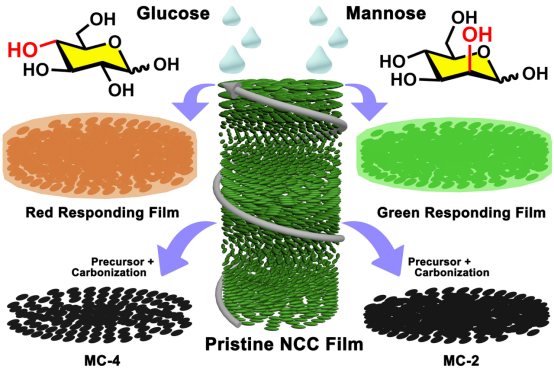Chemoselectivity of Pristine Cellulose Nanocrystal Films Driven by Carbohydrate−Carbohydrate Interactions
Time:2019-08-31 13:44 Author:
Chemoselectivity of Pristine Cellulose Nanocrystal Films Driven by Carbohydrate−Carbohydrate Interactions
Fusheng Zhang, Dongdong Wang, Haijuan Qin, Liang Feng, Xinmiao Liang*, and Guangyan Qing*
ACS Applied Materials & Interfaces, 2019, 11, 13114-13122.
DOI: 10.1021/acsami.9b00471

Biological photonic nanostructures comprising hierarchically self-assembled cellulose nanocrystal (CNC) have been exploited for the development of sensing, optoelectronics, and energy materials. Although multiple techniques are used for controlling the optical response and chiral nematic structure of the CNC-derived materials, the presence of external studies that pristine CNC has chemoselectivity is not yet reported to implement this destination. Here, we report that CNC film without modification shows a high optical sensitivity for glucose through color variation from blue to red. Moreover, various glucose homologs or analogs that only differ in terms of the orientation of a hydroxyl group are selectively distinguished through the naked eye. The excellent chemoselectivity of CNC is attributed to carbohydrate–carbohydrate selective hydrogen bonding interactions. Close binding with glucose induces the rearrangement of a CNC chain and strengthens repulsive interaction, thus increasing the helical pitch of the chiral nematic structure of the CNC film and changing its macroscopic color. This CNC chemoselectivity presents an unprecedented control of chiral nematic mesoporous carbon through monosaccharide species. The results provides a simple but highly efficient method to tune the optical and structural properties of CNC nanomaterials and to apply them for practical biosensor, chiral separation, and energy applications.